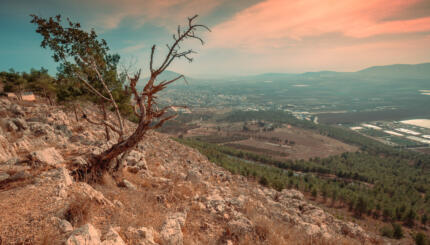Reprinted from The Jewish Religion: A Companion, published by Oxford University Press.
Holy Sparks are the spiritual illuminations inherent in all things. The doctrine, as found in the kabbalistic system of Isaac Luria, the Ari, runs that when the light of Ein Sof, the Limitless Ground of Being, poured into the vessels which were to receive this light in order to produce the sefirot, the powers or potencies in the Godhead, the light was too strong to become limited in the vessels of the seven lower sefirot, those at a greater distance, so to speak, from the infinite light of Ein Sof.
As a result, there took place the “breaking of the vessels.” When the vessels were broken, the lights returned to their source; but not all the lights returned. “Sparks” of the lights remained, adhering to the broken shards in order to keep them in being.
The Sparks Spill Over
The sefirot were reconstituted after the breaking of the vessels, reinforced so that they could contain the light, using in the process the further light that streamed forth but also the holy sparks in the broken shards. This restoration resulted in an overspill of the light in the highest of the four worlds, the World of Emanation.
With your help, My Jewish Learning can provide endless opportunities for learning, connection and discovery.
From this overspill the World of Creation was constituted but here, too, there was an overspill and this constituted the World of Formation and here again there was an overspill to constitute the lowest world of the four, the World of Action. The idea behind all this is that fewer sparks are required for the formation of the worlds as they descend; less energy is required to keep lower worlds in existence, so that as the sparks flash out those which are redundant so far as that world is concerned spill over to create the next, lower world.
The Kelipot or Evil
There is a further overspill from the World of Action and it is this which nourishes the kelipot, the “shells” or “husks,” the demonic forces which feed on the sacred realms while attacking them. In this way the effect of the breaking of the vessels results in holy sparks being imprisoned among the kelipot. It is the human task to reclaim these sparks for the holy and by so doing to assist the fallen worlds to be restored to their former harmony. The reclaiming of the holy sparks from the kelipot is achieved by rejecting evil, that is, by obeying the negative precepts of the Torah. 
The highest of the kelipot is not totally evil, as are the others, but is ambiguously holy and unholy and the sparks therein are reclaimed by directing aright the natural drives of the body and so bringing this kelipah into the realm of the holy. Every evil deed keeps the holy sparks imprisoned among the kelipot,
Conversely, every good deed assists in the reclaiming of the holy sparks and ultimately the restoration of cosmic harmony. When the task of restoration is complete, when all the sparks have been reclaimed for the holy, the Messiah will come and the disharmony resulting from the breaking of the vessels will be no more and cosmic redemption will have been achieved.
Reclaiming the Sparks
At first it was intended for the reclaiming of the holy sparks to be performed by Adam, whose great soul embraced all the souls of humanity. If Adam had obeyed God, harmony would have been restored throughout all creation. But, as a result of Adam’s disobedience, there took place a second cosmic fall, repeating as it were, the original breaking of the vessels. Adam’s soul became fragmented, each of his descendants having a mere spark of Adam’s mighty soul.
Thus the Lurianic School thinks of two kinds of sparks. The first are those which fell when the vessels were shattered. The second are the sparks of Adam’s soul. It is not only the sparks in creation that require reclamation, but, in addition, every soul has its own task, the perfection of that particular spark of Adam’s soul. A vast cosmic drama is being played out with the human being in the central role. Each human being has his or her own holy spark, an inheritance from the first father of the human race, and each has to reclaim the holy sparks in creation, both of which tasks are achieved by keeping the precepts of the Torah.
When Israel was given the Torah and accepted it, humanity was given a second chance to produce harmony in the sefirotic realm. But when the people worshipped the golden calf the catastrophic breach was repeated and all was in disarray again. The process of reclaiming the sparks now had to be a gradual one, to be completed only in the far-off Messianic age. The risk of a third catastrophic failure could only be averted by a step-by-step restoration rather than an immediate storming of the heavens.
Shabbatean Approach
The followers of the false Messiah, Shabbetai Zevi, in the 17th century, when the supposed Messiah embraced Islam, developed a radical theology based on the doctrine of the holy sparks. In this system the final reclamation of the holy sparks could only be achieved by the Messiah himself descending into the realm of the kelipot, consciously embracing Islam in order to rescue the sparks still awaiting their redemption there.
Long after Shabbetai’s death, his still-faithful followers were captivated by this intoxicating notion of the holy sin, adopting it as a task to be undertaken not only by the Messiah but by all believers. These later Shabbateans outwardly kept all the observances of the Torah but secretly endeavored to rescue, by the performance of illegal acts, the holy sparks imprisoned among the kelipot.
This involved a complete reversal of the Lurianic kabbalah. In the Lurianic scheme it is never permitted to rescue the holy sparks through sinful acts. On the contrary, refraining from sin was one of the ways in which the sparks were to be rescued and the restoration completed.
Hasidism and the Holy Sparks
The doctrine of the holy sparks occupies a prominent place in Hasidism. But in this movement the whole doctrine was further developed in two ways. First, unlike in the Lurianic kabbalah, which makes little of the holy sparks residing in food and other worldly things, except when the discussion has to do with the performance of the precepts, Hasidism taught that it is incumbent on the Hasid to be fully engaged in worldly affairs in order to reclaim the holy sparks inherent in the food, drink, and other worldly things.
Secondly, in Hasidism each individual has his own holy sparks, as in the Lurianic system, but, in addition, his own sparks in creation which only he and no other can reclaim. Because of this one finds many Hasidic tales of a master being propelled by a force beyond his control to journey to distant places for no other purpose than to carry out there some task, otherwise neutral or insignificant, that would have the effect of rescuing the holy sparks held there captive by the kelipot–those sparks awaiting the one rescuer whose soul-root is close to them in the divine scheme, like the princess in the ogre’s castle who will only consent to be rescued by the particular knight in shining armor to whom she has plighted her troth.
Hasid
Pronounced: KHAH-seed, Origin: Hebrew, a Hasidic Jew, a follower of Hasidic Judaism, a stream within ultra-Orthodox Judaism that grew out of an 18th-century mystical revival.
Hasidic
Pronounced: khah-SID-ik, Origin: Hebrew, a stream within ultra-Orthodox Judaism that grew out of an 18th-century mystical revival movement.
Torah
Pronunced: TORE-uh, Origin: Hebrew, the Five Books of Moses.


